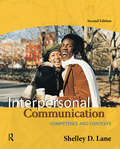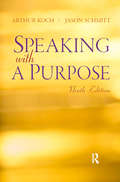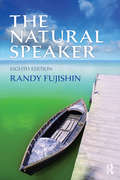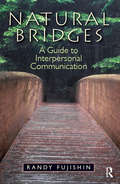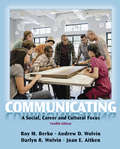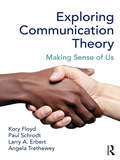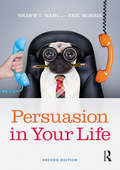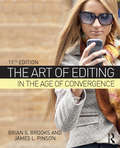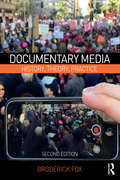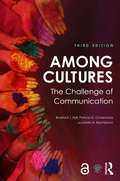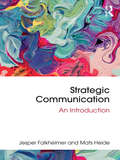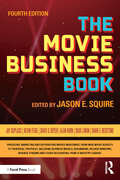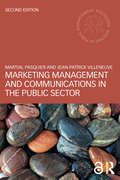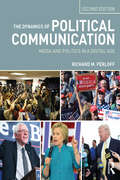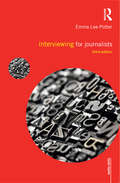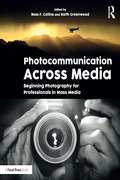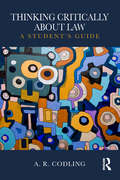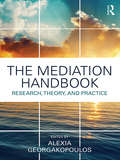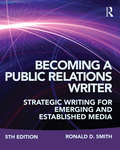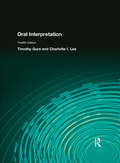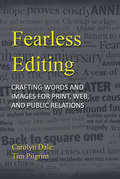- Table View
- List View
Interpersonal Communication: Competence and Contexts
by Shelley D. LaneInterpersonal Communication: Competence and Contexts prepares students to communicate successfully in today's fast-paced and complex society through the implementation of a unique competence-building model. This highly readable text provides the theories, concepts, and applications in a pedagogically sound format based on a model of communication competence made up of three elements: motivation, knowledge, and skill. Studying interpersonal communication through this distinct framework will provide a foundation for students' motivation to communicate competently, increase their knowledge about communication, and enhance their acquisition and performance of communication skills. Covering a broad range of interpersonal communication themes, including strategic alternatives and solutions to communication challenges and information about friendship, family, romantic, and workplace relationships, this Second Edition presents theories, concepts, and activities with engaging examples and an attention-getting design.
Speaking With A Purpose (Myspeechkit Ser.)
by Arthur Koch Jason SchmittEffective speechmaking is vital to anyone who needs to get up in front of an audience. From businesspeople, lawyers, politicians, and clergy to committee chairs, teachers, concerned citizens, and storytellers, competent public speaking is vital to the speaker's credibility. KEY TOPIC: This brief, step-by-step approach to the speechmaking process allows readers to concentrate on the preparation, practice, and presentation without getting bogged down in theoretical discussion. Topics include: getting started, audience analysis, supporting ideas and material, preparation, delivery, and more. MARKET: Ideal for anyone who has to prepare a speech.
Speaking With A Purpose
by Arthur Koch Jason SchmittEffective speechmaking is vital to anyone who needs to get up in front of an audience. From businesspeople, lawyers, politicians, and clergy to committee chairs, teachers, concerned citizens, and storytellers, competent public speaking is vital to the speaker's credibility. KEY TOPIC: This brief, step-by-step approach to the speechmaking process allows readers to concentrate on the preparation, practice, and presentation without getting bogged down in theoretical discussion. Topics include: getting started, audience analysis, supporting ideas and material, preparation, delivery, and more. MARKET: Ideal for anyone who has to prepare a speech.
The Natural Speaker (Myspeechkit Ser.)
by Randy FujishinThe Natural Speaker is a concise, practical, inexpensive, student-friendly guide to public speaking that explores the basic skills necessary to present a natural, effective, and rewarding speech to any audience. By providing a basic knowledge of speech construction, practice, and delivery, this book is designed to enhance and improve students' natural speaking strengths. Featuring a warm, simple, and humorous writing style, The Natural Speaker presents the fundamental concepts and skills required for effective speaking.
The Natural Speaker
by Randy FujishinThe Natural Speaker is a concise, practical, inexpensive, student-friendly guide to public speaking that explores the basic skills necessary to present a natural, effective, and rewarding speech to any audience. By providing a basic knowledge of speech construction, practice, and delivery, this book is designed to enhance and improve students' natural speaking strengths. Featuring a warm, simple, and humorous writing style, The Natural Speaker presents the fundamental concepts and skills required for effective speaking.
Natural Bridges: A Guide to Interpersonal Communication
by Randy FujishinNatural Bridges is a concise, practical, inexpensive, and student-friendly guide to interpersonal communication. This book explores the fundamental principles and skills necessary for effective communication. Building on the theme that our every word and behavior contributes to building a bridge or a barrier in our daily interactions with others, Natural Bridges provides students with concepts and real-world guidelines for productive communication with acquaintances, friends, family-members, romantic partners, and co-workers.
Natural Bridges: A Guide to Interpersonal Communication
by Randy FujishinNatural Bridges is a concise, practical, inexpensive, and student-friendly guide to interpersonal communication. This book explores the fundamental principles and skills necessary for effective communication. Building on the theme that our every word and behavior contributes to building a bridge or a barrier in our daily interactions with others, Natural Bridges provides students with concepts and real-world guidelines for productive communication with acquaintances, friends, family-members, romantic partners, and co-workers.
Communicating: A Social, Career, and Cultural Focus
by Andrew Wolvin Darlyn R. Wolvin Roy Berko Joan E. AitkenThis highly-regarded introduction to communication book offers a comprehensive blend of basic communication theory, research, and skills, with a strong emphasis on relationship communication (social), workplace (career), and intercultural communication (culture). Communicating introduces the basic principles of communication and applies them to interpersonal, group, interviewing, and public speaking contexts. The book stresses communication competence through boxed material, Learn by Doing activities, thought-provoking questions, and self-assessment tests. New and strengthened pedagogy highlights and reinforces the book's social, career, and cultural themes, with a particular emphasis on intercultural communication and communicating in an increasingly high-tech, global environment.
Exploring Communication Theory: Making Sense of Us
by Kory Floyd Paul Schrodt Larry Erbert Angela TretheweyThis text presents and explains theories from the epistemological perspectives of the researchers who use them. Rather than representing a specific theoretical paradigm (social scientific, interpretive, or critical), the author team presents the three major paradigms in one text, each writing in his or her area of expertise. Every theory is explained in a "native" voice, from a position of deep understanding and experience, improving clarity for readers. The text also provides insights on using communication theory to address real-life challenges. Considering that theories are developed to guide scholarly research more than to provide practical advice, this feature of the book helps students create realistic expectations for what theories can and cannot do and makes clear that many theories can have practical applications that students can use to their advantage in everyday life. Offering a comprehensive exploration of communication theories through multiple lenses, Exploring Communication Theory provides an integrated approach to studying communication theory and to demonstrating its application in the world of its readers.
Persuasion in Your Life
by Shawn T. Wahl Eric MorrisPersuasion in Your Life, 2nd Edition speaks directly to the student by focusing on real-life experiences, from critically viewing persuasive public campaigns to making business and health care decisions. This new edition concludes with a new chapter on the assessment of persuasive messages. It also features new chapter-opening vignettes that immediately apply concepts to daily life, as well as "What You’ve Learned" reviews for comprehension. Students and instructors can use the wealth of online resources that accompany this text, including an instructor manual, Power Point slides, test questions, and more. Through its use of rhetoric, criticism, and social scientific research, this book helps readers understand, analyze, and use persuasion in their life and career.
The Art of Editing in the Age of Convergence
by Brian S. Brooks James L. PinsonThe Art of Editing in the Age of Convergence remains the most comprehensive and widely used text on editing in journalism. This latest edition continues to shift the focus toward online multimedia as more and more people get their news that way. Amid these changes, the authors continue to stress the importance of taking the best techniques learned in print and broadcast editing and applying them to online journalism. The reality is that most people now often first learn of breaking news on Facebook or Twitter, and therefore the challenge for journalists in this new media world is distinguishing the quality and dependability of their work from all the fake news and propaganda memes, now so common online. This book is designed to help serious news providers produce a product that is well-edited and grounded in the best practices of journalism.
Documentary Media: History, Theory, Practice
by Broderick FoxIn a digital moment where both the democratizing and totalitarian possibilities of media are unprecedented, the need for complex, ethical, and imaginative documentary media—for you, the reader of this book to think, question, and create—is vital. Whether you are an aspiring or seasoned practitioner, an activist or community leader, a student or scholar, or simply a curious audience member, author Broderick Fox opens up documentary media, its changing forms, and diversifying social functions to readers in a manner that is at once rigorous, absorbing, and practical. This new edition updates and further explores the various histories, ideas, and cultural debates that surround and shape documentary practice today. Each chapter engages readers by challenging traditional assumptions, posing critical and creative questions, and offering up innovative historical and contemporary examples. Additionally, each chapter closes with an "Into Practice" section that provides analysis and development exercises and hands-on projects that will assist you in generating a full project prospectus, promotional trailer, and web presence for your own documentary.
Among Cultures: The Challenge of Communication
by Bradford J. Hall Kristin A. Kirschbaum Patricia O. CovarrubiasAmong Cultures: The Challenge of Communication, Third Edition explores intercultural communication and the relationship between communication and culture, using narrative as a common and compelling thread for studying intercultural interactions. Anchored in the position that people make sense of their worlds through choosing and telling narratives to themselves and others, this text is replete with narratives and stories. Chapters address key aspects of intercultural communication, including verbal and nonverbal communication; stereotypes and bias; identity; conflict; diversity; and ethics. Using an interpretive approach to intercultural communication, the text helps students understand that although a person may appear different, his/her common sense is quite reasonable within a particular interpretive context. Resources are included to help students understand and explain the reasonableness of other cultural systems. The text includes activities for students to complete while reading, including self-assessments and nonverbal self-knowledge tests. Reflection questions within and at the end of each chapter promote thinking and discussion on each topic. With its unique approach to studying intercultural communication via real-life narratives, this text facilitates a deep understanding of the cultural aspects of communication. In providing the narratives of others, it encourages students to tell their own stories and build a strong foundation for communicating across cultures. New to the Third Edition: New chapter—"What Role Does Culture Play in Contemporary Contexts?"—explores intercultural communication as it relates to the environment, health, and technology. New sections on identity, silence, and terms of address as important communicative practices in intercultural settings. Updated sections on honorifics, key terms, social dramas and the golden approaches to ethics.
Strategic Communication: An Introduction
by Jesper Falkheimer Mats HeideStrategic communication comprises different forms of goal-oriented communication inside and between organizations, their stakeholders and the society. Strategic communication is an emerging practice and research field integrating established disciplines such as public relations, organizational communication and marketing communication into a holistic framework. The field is based on an awareness of the fundamental importance of communication for the existence and performance of all organizations. This textbook offers a broad insight into the field of strategic communication. The main aim of the book is to give a general overview of theories, concepts and methods in strategic communication. The book also aims to develop an understanding of different perspectives and the consequences each one has for practice. After reading the book the student or reader will be able to define and reflect upon strategic communication as an academic field and professional practice, describe relevant theories and apply these to communication problems. The authors apply a reflective and practice-oriented approach meaning earlier research or theories are not only described, but also discussed from different critical perspectives. A practice-oriented approach means, in this book, that the authors strongly emphasize the role of contexts and situations—where strategic communication actually happens. This book will help business and communications students to not only define and understand a variety of strategic communications theories, but to use those theories to generate communication strategy and solutions.
The Movie Business Book
by Jason E. SquireTapping experts in an industry experiencing major disruptions, The Movie Business Book is the authoritative, comprehensive sourcebook, covering online micro-budget movies to theatrical tentpoles. This book pulls back the veil of secrecy on producing, marketing, and distributing films, including business models, dealmaking, release windows, revenue streams, studio accounting, DIY online self-distribution and more. First-hand insider accounts serve as primary references involving negotiations, management decisions, workflow, intuition and instinct. The Movie Business Book is an essential guide for those launching or advancing careers in the global media marketplace.
Marketing Management and Communications in the Public Sector (Masters in Public Management)
by Martial Pasquier Jean-Patrick VilleneuveThis updated edition of Marketing Management and Communications in the Public Sector provides a thorough overview of the major concepts in public sector marketing and communications, two fields that have continued to grow in importance for modern public administrations. With extended coverage of topics such as social marketing and institutional communication, the authors skilfully build on the solid foundations laid down in the previous edition. Replete with real-world case studies and examples, including new material from the USA, Australia, and Asia, this book gives students a truly international outlook. Additional features include exercises and discussion questions in each chapter and an illustrative extended case study. This refreshed text is essential reading for postgraduate students on public management degrees, and aspiring or current public managers. The Open Access version of this book, available at http://www.taylorfrancis.com/books/e/9781315622309, has been made available under a Creative Commons Attribution-Non Commercial-No Derivatives 4.0 license.
The Dynamics of Political Communication: Media and Politics in a Digital Age
by Richard M. PerloffWhat impact do news and political advertising have on us? How do candidates use media to persuade us as voters? Are we informed adequately about political issues? Do twenty-first-century political communications measure up to democratic ideals? The Dynamics of Political Communication: Media and Politics in a Digital Age, Second Edition explores these issues and guides us through current political communication theories and beliefs by detailing the fluid landscape of political communication and offering us an engaging introduction to the field and a thorough tour of the discipline. Author Richard Perloff examines essential concepts in this arena, such as agenda-setting, agenda-building, framing, political socialization, and issues of bias that are part of campaign news. Designed to provide an understanding and appreciation of the principles involved in political communication along with methods of research and hypothesis-testing, each chapter includes materials that challenge us by encouraging reflection on controversial matters. Inside this Second Edition you’ll find: Expanded discussion of conceptual problems, communication complexities, and key issues in the field. New examples, concepts, and studies reflecting current political communication scholarship. The integration of technology throughout the text, reflecting its pervasive role in the political spectrum. Accompanied by an updated companion website with resources for students and instructors, The Dynamics of Political Communication prepares you to survey the political landscape with a more critical eye, and encourages a greater understanding of the challenges and occurrences presented in this constantly evolving field.
Interviewing for Journalists (Media Skills)
by Emma Lee-PotterInterviewing for Journalists focuses on the central journalistic skill of how to ask the right questions in the right way. It is a practical and concise guide for all print and online journalists – professionals, students and trainees – who write news stories and features for newspapers, magazines and online publications. In the age of digital journalism, where computer-based research is easily available, this new edition seeks to emphasise the value of getting out there, engaging with people directly and building relationships to create original and meaningful media content. Interviewing for Journalists highlights the many different approaches to interviewing, from vox pops and press conferences to news interviews and in-depth profiles. This third edition features brand new interviews with some of the most successful journalists in the industry, including Camilla Long of The Sunday Times, Heidi Blake of BuzzFeed UK, Brian Viner of the Daily Mail and award-winning freelance writers Cole Moreton and Stephanie Rafanelli. It covers every stage of interviewing, such as research, fixing interviews, structuring questions, body language, how to get vivid quotes and how to handle challenging interviews. The third edition of Interviewing for Journalists includes: advice on how to carry out face-to-face, telephone and online interviews; tips on taking notes, shorthand and recording interviews; guidance on dealing with different interviewees, such as celebrities, politicians and vulnerable people; interviewing tasks to put your journalistic skills into practice; a discussion of ethical and legal issues by Professor Tim Crook of Goldsmiths, University of London.
Photocommunication Across Media: Beginning Photography for Professionals in Mass Media
by Ross Collins Keith GreenwoodPhotocommunication Across Media is a must-have for aspiring mass media professionals who are striving to compete in the new landscape of convergence journalism and media. You will learn principles of photography both still and video and how to incorporate them into your storytelling. That’s no longer a specialty skill—in today’s world of media, it’s a necessity. Editors Ross Collins and Keith Greenwood collaborate with highly accomplished photographers to make the concepts and techniques of today’s mass media photography accessible to all readers. Photocommunication Across Media speaks directly to journalists, advertisers and professional communicators who want to round out their toolkit without sifting through dense texts meant specifically for photographers and photojournalists. This guide, edited by experts who teach these concepts to the next generation of media professionals, is everything you need to know—and nothing you don’t—to take the next step for your career in communication.
Thinking Critically About Law: A Student's Guide
by A. R. CodlingSo you’ve arrived at university, you’ve read the course handbook and you’re ready to learn the law. But is knowing the law enough to get you the very best marks? And what do your lecturers mean when they say you need to develop critical and analytical skills? When is it right to put your own views forward? What are examiners looking for when they give feedback to say that your work is too descriptive? This book explores what it means to think critically and offers practical tips and advice for students to develop the process, skill and ability of thinking critically while studying law. The book investigates the big questions such as: What is law? and What is ‘thinking critically’? How can I use critical thinking to get better grades in assessments? What is the role of critical thinking in the work place? These questions and more are explored in Thinking Critically About Law. Whether you have limited prior experience of critical thinking or are looking to improve your performance in assessments, this book is the ideal tool to help you enhance your capacity to question, challenge, reflect and problematize what you learn about the law throughout your studies and beyond.
The Mediation Handbook: Research, theory, and practice
by Alexia GeorgakopoulosThe Handbook of Mediation gathers leading experts across fields related to peace, justice, human rights, and conflict resolution to explore ways that mediation can be applied to a range of spectrums, including new age settings, relationships, organizations, institutions, communities, environmental conflicts, and intercultural and international conflicts. The text is informed by cogent theory, state-of-the-art research, and best practices to provide the reader with a well-rounded understanding of mediation practice in contemporary times. Based on four signature themes—contexts; skills and competencies; applications; and recommendations—the handbook provides theoretical, applicable, and practical insight into a variety of key approaches to mediation. Authors consider modern conflict on a local and global scale, emphasizing the importance of identifying effective strategies, foundations, and methods to shape the nature of a mediation mindfully and effectively. With a variety of interdisciplinary perspectives, the text complements the development of the reader’s competencies and understanding of mediation in order to contribute to the advancement of the mediation field. With a conversational tone that will welcome readers, this comprehensive book is essential reading for students and professionals wanting to learn a wide range of potential interventions for conflict.
Becoming a Public Relations Writer: Strategic Writing for Emerging and Established Media
by Ronald D. SmithBecoming a Public Relations Writer is a comprehensive guide to the writing process for public relations practice. Using straightforward, no-nonsense language, realistic examples, easy-to-follow steps, and practical exercises, this text introduces the various formats and styles of writing you will encounter as a public relations practitioner. A focus on ethical and legal issues is woven throughout, with examples and exercises addressing public relations as practiced by corporations, non-profit agencies, and other types of organizations both large and small. In addition, the book offers the most comprehensive list of public relations writing formats to be found anywhere—from the standard news release to electronic mail and other opportunities using a variety of technologies and media. The fifth edition has been updated to reflect significant developments in the public relations field, including: New and updated information on research into persuasion and social psychology aimed at helping readers be more influential in their writing. Significant updating on a new chapter on multimedia, introducing a new transmedia format for a comprehensive news package for print, broadcast, online and social media. Expansion of a chapter on websites, blogs and wikis. Expansion of the chapter on direct mail and online appeals. Updated examples of actual pieces of public relations writing. A companion website with resources for instructors and students, including a glossary, flashcards, exercises, and appendices on ethical standards, careers in public relations, and professional organizations. Through its comprehensive and accessible approach, Becoming a Public Relations Writer is an invaluable resource for future and current public relations practitioners.
Becoming a Public Relations Writer: Strategic Writing for Emerging and Established Media
by Ronald D. SmithBecoming a Public Relations Writer is a comprehensive guide to the writing process for public relations practice. Using straightforward, no-nonsense language, realistic examples, easy-to-follow steps, and practical exercises, this text introduces the various formats and styles of writing you will encounter as a public relations practitioner. A focus on ethical and legal issues is woven throughout, with examples and exercises addressing public relations as practiced by corporations, non-profit agencies, and other types of organizations both large and small. In addition, the book offers the most comprehensive list of public relations writing formats to be found anywhere—from the standard news release to electronic mail and other opportunities using a variety of technologies and media. The fifth edition has been updated to reflect significant developments in the public relations field, including: New and updated information on research into persuasion and social psychology aimed at helping readers be more influential in their writing. Significant updating on a new chapter on multimedia, introducing a new transmedia format for a comprehensive news package for print, broadcast, online and social media. Expansion of a chapter on websites, blogs and wikis. Expansion of the chapter on direct mail and online appeals. Updated examples of actual pieces of public relations writing. A companion website with resources for instructors and students, including a glossary, flashcards, exercises, and appendices on ethical standards, careers in public relations, and professional organizations. Through its comprehensive and accessible approach, Becoming a Public Relations Writer is an invaluable resource for future and current public relations practitioners.
Oral Interpretation
by Timothy Gura Charlotte LeeFor over fifty years, Oral Interpretation has successfully prepared students to analyze and perform literature through an accessible, step-by-step process. The authors classic commitment to helping students understand literature then to embody and evoke the work has been refined to offer students a more concise, user-friendly process that will help them succeed in their daunting first performance. Updated with a tightly edited collection of classic and contemporary selections, each chapter provides a wide variety of selections for students at all levels. Chapters devoted to each genre---narrative, poetry, drama, group performance–explore the unique challenges of each form while newly revised chapters on Using the Body and Using the Voice in performance introduce students to technical exercises to promote performance flexibility.
Fearless Editing: Crafting Words and Images for Print, Web, and Public Relations
by Carolyn Dale Tim PilgrimFearless Editing clearly articulates the basic concepts underlying editing techniques and demonstrates their application for newspapers, public relations, magazines and Web pages. This text takes a conceptual approach that integrates verbal skills with visual elements. Unlike other texts that are clearly designed for print, this book includes multi-media applications in every chapter.
